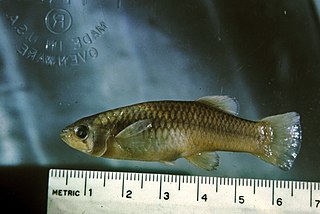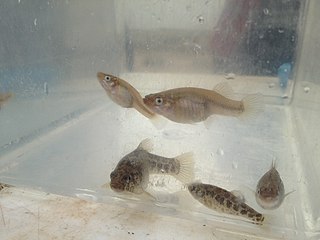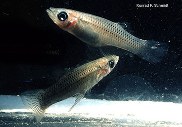
The International Union for Conservation of Nature (IUCN) Red List of Threatened Species, also known as the IUCN Red List or Red Data Book, founded in 1964, is an inventory of the global conservation status and extinction risk of biological species. A series of Regional Red Lists, which assess the risk of extinction to species within a political management unit, are also produced by countries and organizations.

Gambusia is a large genus of viviparous fish in the family Poeciliidae. Gambusia contains over 40 species, most of which are principally found in freshwater habitats, though some species may also be found in brackish or saltwater habitats. The genus Gambusia comes from the Cuban term, "Gambusino", which means "free-lance miner". The type species is the Cuban gambusia, G. punctata. The greatest species richness is in Mexico, Texas, and the Greater Antilles, but species are also found elsewhere in the eastern and southern United States, the Bahamas, Central America, and Colombia. Gambusia species are often called topminnows, or simply gambusias; they are also known as mosquitofish, which, however, refers more specifically to two species, G. affinis and G. holbrooki, which are often introduced into ponds to eat mosquito larvae. As a consequence, they have been introduced widely outside their native range, and frequently become invasive, threatening local species. G. affinis and G. holbrooki are now established in many parts of the world and are likely to continue to spread as climatic conditions change. They are only occasionally kept in aquariums, due to their relative lack of color and the highly aggressive nature of the aforementioned mosquitofish species.

The Alaotra grebe, also known as Delacour's little grebe or rusty grebe, is a recently extinct grebe that was endemic to Lake Alaotra and its surrounding lakes in Madagascar. Experts say that the grebe became extinct after carnivorous fish were introduced into its native habitat.

Amistad Reservoir is a reservoir on the Rio Grande at its confluence with the Devils River 12 miles (19 km) northwest of Del Rio, Texas. The lake is bounded by Val Verde County on the United States side of the international border and by the state of Coahuila on the Mexican side of the border; the American shoreline forms the Amistad National Recreation Area. The reservoir was formed in 1969 by the construction of Amistad Dam. The dam and lake are managed jointly by the governments of the United States and Mexico through the International Boundary and Water Commission. The name of the dam and lake is the Spanish word for "friendship". The reservoir is also known as Lake Amistad.
The San Marcos gambusia is a likely extinct species of Gambusia from the family Poeciliidae that was found only in the San Marcos Springs of Central Texas. The fish has not been seen since 1983.

Acanthobrama telavivensis, commonly known as the Yarkon bream or Yarkon bleak, is a species of freshwater ray-finned fish of the family Cyprinidae found only in Israel, in the Yarkon River system.
The Snake River sucker is an extinct species of ray-finned fish in the family Catostomidae. It was endemic to the Snake River below Jackson Lake Dam in Wyoming. Described from a single specimen, it is now presumed to be an extinct species.
The Mexican dace, or Mexican chub, is an extinct species of ray-finned fish in the family Cyprinidae. It was found only in Mexico, in the canals and streams of the Valley of Mexico. It is estimated to have become extinct circa 1983. The extinction of this species coincided with the drying of water bodies in the valley. This drying was a result of the increasing demands placed on the water resources of the valley by agriculture, as well as by the growth of Mexico City and its suburbs.
Chirostoma bartoni, the Alberca silverside, is a species of neotropical silverside endemic to the Lerma River basin of Mexico. Typical adult specimens are approximately 7.1 cm in length.

The Big Bend gambusia is a rare species of fish in the family Poeciliidae. It is endemic to the Big Bend region of the Rio Grande of the United States and Mexico. The only known remaining population is in a protected pond in the Big Bend National Park.

The Clear Creek gambusia is a species of fish in the family Poeciliidae endemic to the United States, particularly Menard County, Texas.

The Pecos gambusia is a species of fish in the family Poeciliidae endemic to the Pecos River in Texas and New Mexico in the United States. This two-inch species, as most of its family, is a livebearer. Females produce broods of up to 40 fry every four to five days. The fish are omnivorous, eating algae and small invertebrates, and are endangered due to loss of their spring-fed desert habitat.
Gambusia senilis, the blotched gambusia, is a species of fish in the family Poeciliidae found in Mexico, where it is called guayacon pinto, and formerly in the Devil's River in the Rio Grande basin in Texas. The Texas population was extirpated following the construction of the Amistad Dam.
The Scioto madtom was a species of fish in the family Ictaluridae. It is listed as extinct by the International Union for Conservation of Nature, which notes that it has likely been entirely or functionally extinct since 1957 given the lack of records since that year.
Tristramella intermedia is an extinct species of fish in the family Cichlidae. It was endemic to Lake Hula in northern Israel. This taxon was considered to be a subspecies of T. simonis in FishBase and considered a synonym of T. simonis by Catalog of Fishes, a view with which FishBase now concurs. This species reached a length of 22.9 centimetres (9.0 in) TL.

The Mangrove gambusia is a tropical poeciliid fish species with a restricted, disjunct range one in northwestern Cuba, the other in southeastern Florida. The Florida population has been recently listed as "biologically vulnerable" by the Florida Fish and Wildlife Conservation Commission.
Chirostoma charari, the least silverside, is a species of neotropical silverside endemic to Mexico. This species has only been found in a spring in the Lake Cuitzeo basin on the Mesa Central of the Mexican Plateau. It has a longer head and jaw, as well as larger teeth and eyes than other Chirostoma species. Its status is rated as Critically Endangered by the IUCN, and may possibly be extinct.









